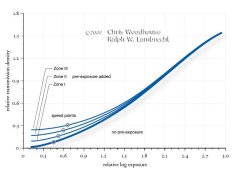Stephen Benskin
Member
Steve
Before I labor through your long note, could you please paraphrase, in a sentence or two, what you are trying to get across? I cannot get rid of the feeling that we are in violent agreement, and just prefer to expose and process our films differently. Keep in mind, nobody questions ISO. We are just trying to clarify what EI means to different people.
Jack Dunn's book is missing in my otherwise pretty extensive library, so I ordered a used copy on the web. (Actually, I accidentally ordered two, so, if somebody is interested?) Interestingly enough, it is published by the same company as mine, and I still have never heard of it. I'll never seize to learn.
Well, I find there are two different "types" of EIs. One is simply how you want to set the meter. It can be to give the film a little more exposure or to "push for speed." The other type concerns the Effective Film Speed of the film. Effective film speed is the speed derived from testing outside the method specified in the standard. You can't use the ISO prefix, but it still represents a quantitative result from some form of testing.
My contention is that in most instances, because of incorrect assumptions, the EFS type of EIs many think they are getting is really the other type. Then assuming they have an accurate result, they ascribe false attributes to the ISO standard. They now believe they have the "real" speed of the film, or that they have a personal speed that better reflects their methods. What they are really doing is working under the false sense of accuracy thinking that they have an EFS type of EI when they don't.
When I present certain facts without supporting evidence and they are rejected, I then need to explain them. There are certain fundamental concepts that have to be understood before it's possible to overturn those false assumptions. For example, you and I have talked previously about the Delta-X Criterion and I've had to present large amounts of documented information to support it. Tell you the truth, I still don't think you believe it. Even within this thread there has been rejections of the fractional gradient point as the minimal useful density point and the information presented in the exposure chart. And others aren't advanced as you.
People can explain how to do Zone System testing, but does anyone ever wonder if it is correct?
Make sure you keep the fourth edition of Exposure Manual.


 . To my understanding, the basic fractional gradient at point #1 (what is it's log exposure value by the way?) on the graph you presented basically "looks" to be a base+fog level on any other graph as far as I can tell. I can't print that on my paper with any degree of satisfaction. So, it then becomes irrelevant to me. If I can't print it, it is non-essential information.
. To my understanding, the basic fractional gradient at point #1 (what is it's log exposure value by the way?) on the graph you presented basically "looks" to be a base+fog level on any other graph as far as I can tell. I can't print that on my paper with any degree of satisfaction. So, it then becomes irrelevant to me. If I can't print it, it is non-essential information.


